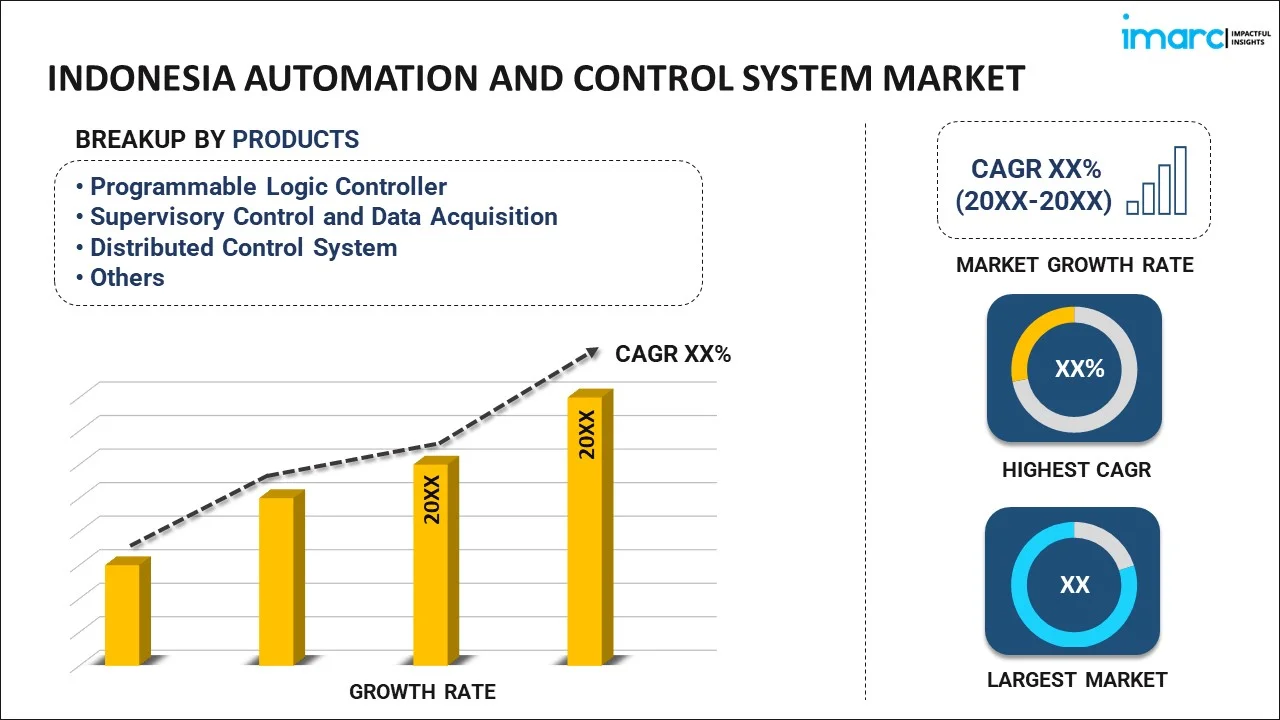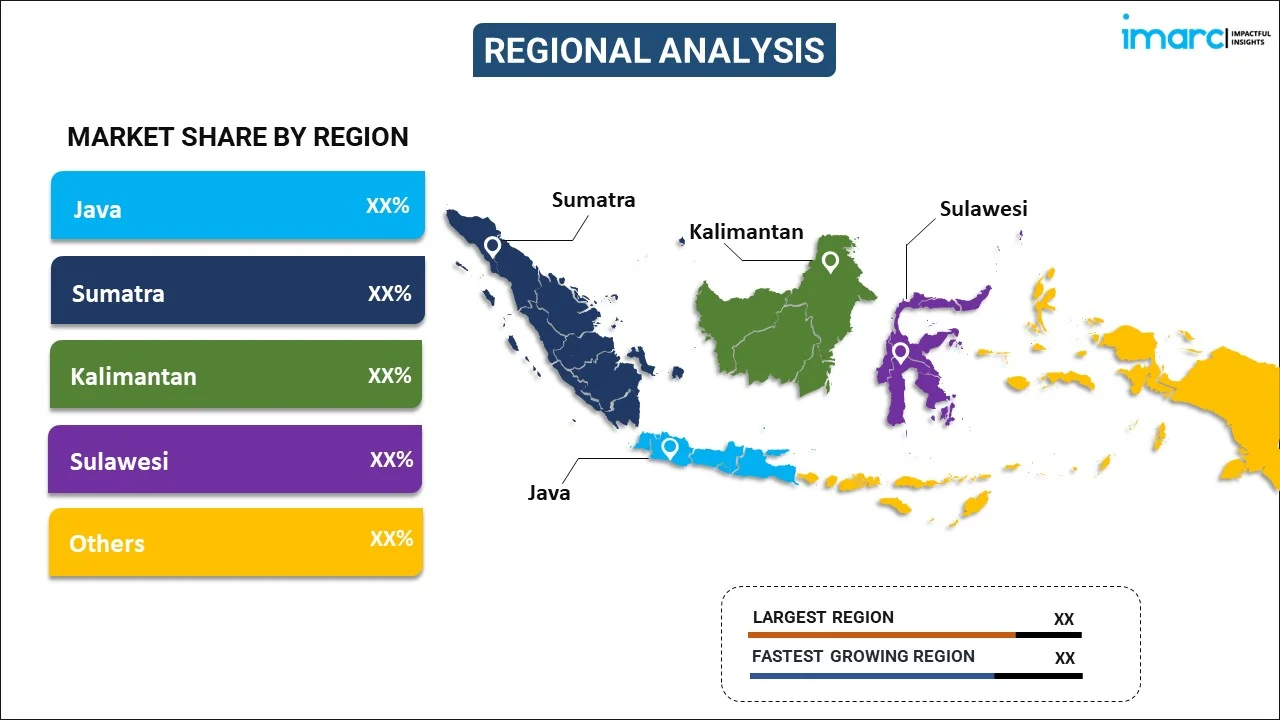
Indonesia Automation and Control System Market Report by Product (Programmable Logic Controller, Supervisory Control and Data Acquisition, Distributed Control System, Human Machine Interface, Safety Systems, Industrial Robotics, Electric Motors, Drives), End Use Industry (Oil and Gas, Power, Chemical and Petrochemical, Food and Beverage, Metals and Mining, Water and Wastewater, and Others), and Region 2024-2032
Market Overview:
Indonesia automation and control system market size is projected to exhibit a growth rate (CAGR) of 8.10% during 2024-2032. Rapid industrialization, a focus on operational efficiency, surging sustainability goals, the integration of the internet of things (IoT) and Industry 4.0, the availability of a skilled labor force, and a growing ecosystem of solution providers are stimulating the market growth.
|
Report Attribute
|
Key Statistics
|
|---|---|
|
Base Year
|
2023 |
|
Forecast Years
|
2024-2032 |
|
Historical Years
|
2018-2023
|
| Market Growth Rate (2024-2032) | 8.10% |
Automation and control systems are integral components of modern industrial processes, playing a pivotal role in enhancing efficiency, precision, and reliability. They are meticulously designed and constructed to facilitate the automatic operation and monitoring of various equipment and processes. They serve as the backbone of industries, such as manufacturing, energy, and transportation, where the need for seamless coordination and regulation is paramount. The construction of automation and control systems typically involves a combination of hardware and software components. Automation and control systems operate on the principle of feedback control. Sensors continuously monitor the process variables, such as temperature, pressure, or flow rate, and send this data to the controller. The controller then compares the actual values with desired setpoints and makes necessary adjustments to maintain optimal conditions. The advantages of automation and control systems are multifaceted, such as they lead to increased productivity by reducing human error and facilitating production rates. Additionally, they enhance safety by automating hazardous tasks and providing real-time monitoring. Cost efficiency is another benefit, as these systems optimize resource utilization and reduce energy consumption. Moreover, they enable remote monitoring and control, allowing for flexibility in operations. Automation and control systems find extensive applications across various industries, from manufacturing lines in factories to controlling complex chemical processes in refineries. In manufacturing, they ensure consistent product quality and efficient production rates. In the energy sector, these systems play a crucial role in power generation and distribution. They are also employed in transportation systems, optimizing traffic flow and improving safety.
Indonesia Automation and Control System Market Trends:
The Indonesia automation and control system market is influenced by several key drivers, such as the rapid industrialization, which is fueling the demand for automation solutions across various sectors. Moreover, the increasing need for operational efficiency and cost reduction is driving companies to adopt automation technologies, thereby driving the market growth. This is further supported by the growing emphasis on sustainability and environmental conservation, where automation systems play a crucial role in resource optimization. Furthermore, government initiatives to promote automation in manufacturing and infrastructure development are fueling the market growth. Besides this, the surge in foreign direct investments (FDI) in Indonesia is propelling the adoption of advanced automation and control systems to meet international standards, which is stimulating the market growth. Additionally, the rise of the Internet of Things (IoT) and Industry 4.0 is encouraging companies to integrate smart automation solutions for better connectivity and data-driven decision-making, which is facilitating the market growth. Other factors, such as the increasing complexity of industrial processes, the need for real-time monitoring and control, and the expansion of industries like automotive, pharmaceuticals, and food processing, are creating new opportunities for the market growth across the country.
Indonesia Automation and Control System Market Segmentation:
IMARC Group provides an analysis of the key trends in each segment of the market, along with forecasts at the country level for 2024-2032. Our report has categorized the market based on product and end use industry.
Product Insights:

- Programmable Logic Controller
- Supervisory Control and Data Acquisition
- Distributed Control System
- Human Machine Interface
- Safety Systems
- Industrial Robotics
- Electric Motors
- Drives
The report has provided a detailed breakup and analysis of the market based on the product. This includes programmable logic controller, supervisory control and data acquisition, distributed control system, human machine interface, safety systems, industrial robotics, electric motors, and drives.
End Use Industry Insights:
- Oil and Gas
- Power
- Chemical and Petrochemical
- Food and Beverage
- Metals and Mining
- Water and Wastewater
- Others
A detailed breakup and analysis of the market based on the end use industry have also been provided in the report. This includes oil and gas, power, chemical and petrochemical, food and beverage, metals and mining, water and wastewater, and others.
Regional Insights:

- Java
- Sumatra
- Kalimantan
- Sulawesi
- Others
The report has also provided a comprehensive analysis of all the major regional markets, which include Java, Sumatra, Kalimantan, Sulawesi, and Others.
Competitive Landscape:
The market research report has also provided a comprehensive analysis of the competitive landscape in the market. Competitive analysis such as market structure, key player positioning, top winning strategies, competitive dashboard, and company evaluation quadrant has been covered in the report. Also, detailed profiles of all major companies have been provided.
Indonesia Automation and Control System Market Report Coverage:
| Report Features | Details |
|---|---|
| Base Year of the Analysis | 2023 |
| Historical Period | 2018-2023 |
| Forecast Period | 2024-2032 |
| Units | US$ Million |
| Scope of the Report | Exploration of Historical Trends and Market Outlook, Industry Catalysts and Challenges, Segment-Wise Historical and Future Market Assessment:
|
| Products Covered | Programmable Logic Controller, Supervisory Control and Data Acquisition, Distributed Control System, Human Machine Interface, Safety Systems, Industrial Robotics, Electric Motors, Drives |
| End Use Industries Covered | Oil and Gas, Power, Chemical and Petrochemical, Food and Beverage, Metals and Mining, Water and Wastewater, Others |
| Regions Covered | Java, Sumatra, Kalimantan, Sulawesi, Others |
| Customization Scope | 10% Free Customization |
| Report Price and Purchase Option | Single User License: US$ 3699 Five User License: US$ 4699 Corporate License: US$ 5699 |
| Post-Sale Analyst Support | 10-12 Weeks |
| Delivery Format | PDF and Excel through Email (We can also provide the editable version of the report in PPT/Word format on special request) |
Key Questions Answered in This Report:
- How has the Indonesia automation and control system market performed so far and how will it perform in the coming years?
- What has been the impact of COVID-19 on the Indonesia automation and control system market?
- What is the breakup of the Indonesia automation and control system market on the basis of product?
- What is the breakup of the Indonesia automation and control system market on the basis of end use industry?
- What are the various stages in the value chain of the Indonesia automation and control system market?
- What are the key driving factors and challenges in the Indonesia automation and control system?
- What is the structure of the Indonesia automation and control system market and who are the key players?
- What is the degree of competition in the Indonesia automation and control system market?
Key Benefits for Stakeholders:
- IMARC’s industry report offers a comprehensive quantitative analysis of various market segments, historical and current market trends, market forecasts, and dynamics of the Indonesia automation and control system market from 2018-2032.
- The research report provides the latest information on the market drivers, challenges, and opportunities in the Indonesia automation and control system market.
- Porter's five forces analysis assist stakeholders in assessing the impact of new entrants, competitive rivalry, supplier power, buyer power, and the threat of substitution. It helps stakeholders to analyze the level of competition within the Indonesia automation and control system industry and its attractiveness.
- Competitive landscape allows stakeholders to understand their competitive environment and provides an insight into the current positions of key players in the market.
Need more help?
- Speak to our experienced analysts for insights on the current market scenarios.
- Include additional segments and countries to customize the report as per your requirement.
- Gain an unparalleled competitive advantage in your domain by understanding how to utilize the report and positively impacting your operations and revenue.
- For further assistance, please connect with our analysts.
 Inquire Before Buying
Inquire Before Buying
 Speak to an Analyst
Speak to an Analyst
 Request Brochure
Request Brochure
 Request Customization
Request Customization




.webp)




.webp)












